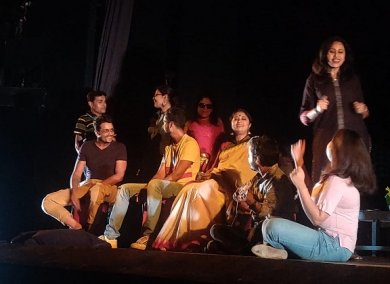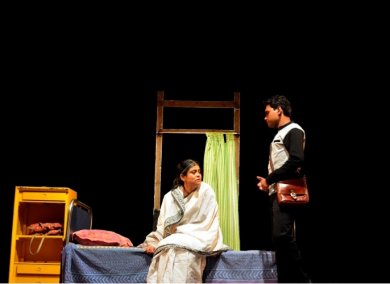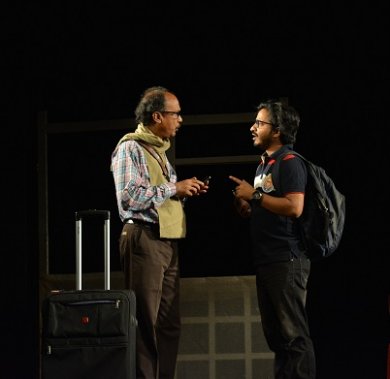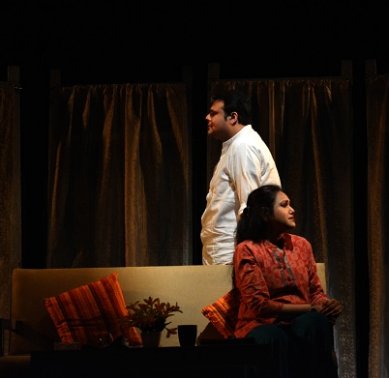
|   |

|   |
 e-mail: ukb7@rediffmail.com Mediating among media Photos courtesy: Ensemble Kolkata November 19, 2019 Alongside the ongoing resplendant programme of Kolkata International Film Festival (KIFF), it is quite befitting to explore cinema's connection with theatre. There have been similar attempts earlier. One genre has been 'Filmed Theatre' capturing theatre perfromances on stage on the celluloid, without any frills or exaggeration. This criitc recalls a Filmed Theatre Festival at the Akashvani Theatre in Mumbai in the 1980s, when he had the privilege of witnessing an array of glitering drama - filmed faihtfully by the camera - in the company of the renowned actress Jennifer Kapoor. Another occasion can be discussion on the difference in acting modes between theatre and cinema. Considering that theatre is a 'live' medium where the dramatic action on stage evokes instant response from the viewers present, while cinema is a 'canned' medium waiting to be exposed to audiences much, much later, the dramatis personnae have to adjust their acting style in the presence of camera or otherwise. This does need clever adjustments which have given us brillaint theatre actors like Utpal Dutt, Shabana Azmi, Naseeruddin Shah and Shah Rukh Khan's calibre, later as famous film stars. (KIFF, at the moment, is holding an interesting discussion session among actors and stars on the subject). 

Chhota Chhabi (The Small Picture) presented on November 11 by the renowned 'Ensemble' group, captured yet a third dimension of this interaction between theatre and cinema by letting the two media make bold forays into each other. The veteran director Sohag Sen - well known for her numerous acting workshops prior to the actors' film shooting schedules - innovated here to make a bunch of film school enthusiasts to make four short films dealing with the theme of urban loneliness. "During the film-making process, they have to face their own dilemma continuously stemming from creativity, finance and, most of all, interpersonal relationships. Whether they are caught by their own webs of isolation is what the play addresses continuously," observes the director. Major part of the play is this "film-making process" comprising "Silence! Order! Camera Rolling! Action!" where the lines between theatre and cinema keep getting obliterated as a matter of routine. The first episode, for instance, begins with shooting where the boy - leaving for abroad probably for good - cajoles the silent mother not to grieve, when she is trying hard to control her wailing tears. All the while, reality is struck by the non-Bengali producer watching the shots, by sitting somewhere among the play's audience. In the second episode, the producer morphs into a stylized, ever busy father as does the socialite mother, who have no time to lend their ears to a desperate daughter trying her desperate best to let them know what she intends to do in life. Her becoming a happy nun -- joining 'Sisters of Charity' in Mother Teresa's 'Nirmal Hriday' -- shatters the parents into a stunned silence. The third episode is a masterpiece of acting by a happy father - dreaming to go to Paris and live with his son and grandson - seen outside the international airport, busy with a lengthy monologue, for bidding farewell to all his dear friends and, in a way, re-living his past life. His lost countenance after having been deserted by his son and slowly looking up at an unexpected charity smiling at him like the sunshine, is well done. The final yarn is in response to the sudden demand by the producer for "a happy ending." There is much heart burning on the overbearing role of finance, dictating Art, and creativity being the sacrificial lamb, after which a short film is produced by the team and is projected on the cyclorama. One views a monumental misunderstanding and an equally classic rapprochement, worked out during an unplanned meeting around a coffee shop table (reminiscent of an earlier short film on a similar theme and similar setup, starring Naseeruddin Shah). Monalisa Chatterjee's acting - almost entirely with her luminous eyes -- as the grievously wronged, other community girl, very slowly coming to terms with a new reality, will stay long with the audience. All told, there is exemplary teamwork in quality acting and synchronized realism in blending the dramatic action, the "coupling" among the playful film institute students -- forming and dissolving forever - come through with due relief, if not always with desired impact. On the whole, it was a wonderful blending of performing arts experience for the spectators. 

Interactions with the Director: Why the play is called "Chhoto Chobi"? The play's title is based on the premise that the new short is the next sweet thing. Worldwide, shorts are being treated new-age because these films ensure limited concentration and, of course, aesthetic stability. My play somewhere reinforces that relationships, too, have a shorter span and art is no exception! Is it your own script? Yes, it is, except the first story, which I have read or heard somewhere. (This critic adds that there is a Bengali song of the 1990s by Nachiketa, Vriddhashram, which ends on the note: 'Let me live another twenty-five years so that my son and I can live, together, in the same old men's abode.') By the way, did you notice that all the tales have a didactic end? Really? How do you view the first story? It is a common fate for many nuclear families that after lovingly bringing up their only child, they are deserted to live in an old-age home. The ending here reminds the child of that startling possibility for himself too! How about the second story? Here the parents are quite well-meaning, it's just that they, like most modern parents, have no time to spare for their child. She had tried to tell them about her choice which, finally, overwhelms the parents because they cannot even comprehend it! What is it about the third? Often in life, after one is ditched by one's loved ones and all hope seems to be lost, there is an oasis of kindness round the corner offered by total strangers. Is the fourth story about getting over communal prejudices? It's much more. Often, our pious thinking stops short with the communal harmony, but here it is welcoming nuptial ties that go beyond overcoming mere prejudices. You surprise the viewers by getting the web of tangled relationships even in the film school characters dealing with themselves... The idea is to show that they are not serious about handling these stories and about their own lives as well. Casualness is almost the order of the day. Lastly, how do you view using music? I do not set much store by music. Here, of course, I have used classical Western music sometimes and, at the end, there is a modern Bengali song about tumultuous relationships entangled with troubled times.  Dr. Utpal K Banerjee is a scholar-commentator on performing arts over last four decades. He has authored 23 books on Indian art and culture, and 10 on Tagore studies. He served IGNCA as National Project Director, was a Tagore Research Scholar and is recipient of Padma Shri. Post your comments Please provide your name and email id when you use the Anonymous profile in the blog to post a comment. All appropriate comments posted with name and email id in the blog will also be featured in the site. |